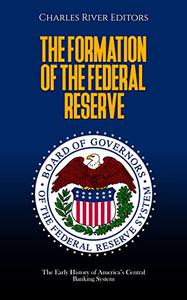
The Formation of the Federal Reserve: The Early History of America's Central Banking System by Charles River Editors
English | December 11, 2022 | ISBN: N/A | ASIN: B0BPVF31NG | 77 pages | EPUB | 2.35 Mb
Debates over paper money and banking are older than the United States of America itself. 18th and 19th century Americans were deeply ambivalent about paper money and central banks, and political fights over these issues were among the bitterest in American history. In fact, controversies over the country's central bank birthed both the first (1792-1824) and second (1828-1852) party systems; frequently, policymakers crafted responses to the crisis at hand, and as a result they implemented policies that were inadequate to the challenges the country faced in the future.
When the national capital relocated to Philadelphia from New York City, Secretary of Treasury Alexander Hamilton set to work on his second major task: the creation of a national Bank of the United States. Hamilton's Bank of the United States was to be privately operated but owned in part by the federal government. Hamilton hoped to strengthen the economic centrality of the federal government by allowing the bank to issue loans, mint currency, handle government funds, and issue treasury notes, but as with Hamilton's proposal to assume the public debts, Southerners opposed the "bank bill." They thought it gave excessive powers to the federal government at the expense of the states, and Hamilton's most ardent political opponent, Thomas Jefferson, had other reasons to oppose the bill. Always a fan of agriculture, Jefferson saw the bank as no friend of farmers, figuring it was geared exclusively towards helping urban businessmen improve their fortunes. To some extent, Hamilton wouldn't disagree with this assessment: he thought the United States was destined not to be a Jeffersonian agrarian nation, but a large industrial one.
The First Bank of the United States had been one of the original issues that helped form the political rift between Hamilton and Jefferson that created the Federalist and Democratic-Republican parties, but it had been re-chartered even with a Democratic-Republican in office in the early 19th century. However, when Andrew Jackson was in office in the summer of 1832, he vetoed the bill to re-charter the Second Bank of the United States, whose current 20-year charter was up. Much as Jefferson opposed the First Bank of the United States, Jackson thought the bill benefitted rich Northern industrialists, not the common man on the frontier. Nicholas Biddle, the bank's president, tried to mobilize support in Congress to pass the bill over the president's veto, but his attempt failed, creating a national controversy over the unsettled status of the country's central bank.
Jackson wanted to kill the bank altogether. To do so, he decided to remove all federal government deposits from the bank, so on September 10, 1833, after his reelection, Jackson ordered that all federal government deposits be removed from the bank. Led by Senator Henry Clay, the Senate censured President Jackson, the first time in history a president was censured, but Jackson also had some supporters.
As this early history suggests, ambivalence toward central banking and paper money, combined with the ad hoc nature of policymakers' responses, caused severe problems. These issues came to a head during the Panic of 1907, which provoked a major reassessment of America's banking system. Progressive Era reformers like President Woodrow Wilson walked a tightrope, balancing fears of centralized wealth with the undeniable need for a rational mechanism to help govern the country's economy. The system they created represented half a loaf, its many compromises and weaknesses corrected by the response to two other crises: the Great Depression and the Cold War. The Federal Reserve System that has existed since the Accord of 1951 has cooled the passionate conflict over central banking and rendered obsolete many of the monetary questions that so animated Americans in previous centuries.
https://1dl.net/bt2q8t79z5li/r1twm.T.F.o.t.F.R.T.E.H.o.A.C.B.S.rar

https://rapidgator.net/file/1b68bf5b48ba581cb97d7013be493f97/r1twm.T.F.o.t.F.R.T.E.H.o.A.C.B.S.rar.html

https://freshwap.cc/view/1C06AA7D5CF8FCD/r1twm.T.F.o.t.F.R.T.E.H.o.A.C.B.S.rar

https://uploadgig.com/file/download/C1e0f25aA121E077/r1twm.T.F.o.t.F.R.T.E.H.o.A.C.B.S.rar
 Views: 0
Views: 0  Comments (0)
Comments (0)
free The Formation of the Federal Reserve The Early History of America's Central Banking System, Downloads The Formation of the Federal Reserve The Early History of America's Central Banking System, RapidShare The Formation of the Federal Reserve The Early History of America's Central Banking System, Megaupload The Formation of the Federal Reserve The Early History of America's Central Banking System, Mediafire The Formation of the Federal Reserve The Early History of America's Central Banking System, DepositFiles The Formation of the Federal Reserve The Early History of America's Central Banking System, HotFile The Formation of the Federal Reserve The Early History of America's Central Banking System, Uploading The Formation of the Federal Reserve The Early History of America's Central Banking System, Easy-Share The Formation of the Federal Reserve The Early History of America's Central Banking System, FileFactory The Formation of the Federal Reserve The Early History of America's Central Banking System, Vip-File The Formation of the Federal Reserve The Early History of America's Central Banking System, Shared The Formation of the Federal Reserve The Early History of America's Central Banking System, Please feel free to post your The Formation of the Federal Reserve The Early History of America's Central Banking System Download, Movie, Game, Software, Mp3, video, subtitle, sample, torrent, NFO, Crack, uploaded, putlocker, Rapidgator, mediafire, Netload, Zippyshare, Extabit, 4shared, Serial, keygen, Watch online, requirements or whatever-related comments here.
Related Downloads :


